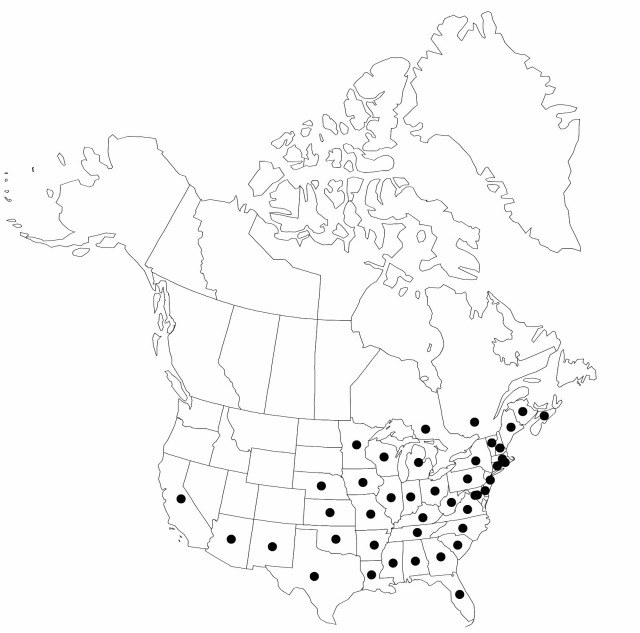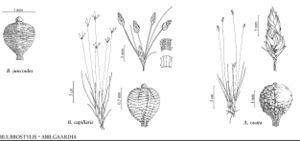Difference between revisions of "Bulbostylis capillaris"
in J. D. Hooker, Fl. Brit. India 6: 652. 1893.
FNA>Volume Importer |
FNA>Volume Importer |
||
| Line 15: | Line 15: | ||
|name=Bulbostylis capillaris var. crebra | |name=Bulbostylis capillaris var. crebra | ||
|authority=Fernald | |authority=Fernald | ||
| − | }}{{Treatment/ID/Synonym | + | }} {{Treatment/ID/Synonym |
|name=Bulbostylis capillaris var. isopoda | |name=Bulbostylis capillaris var. isopoda | ||
|authority=Fernald | |authority=Fernald | ||
| − | }}{{Treatment/ID/Synonym | + | }} {{Treatment/ID/Synonym |
|name=Fimbristylis capillaris | |name=Fimbristylis capillaris | ||
|authority=(Linnaeus) Roemer & Schultes | |authority=(Linnaeus) Roemer & Schultes | ||
| − | }}{{Treatment/ID/Synonym | + | }} {{Treatment/ID/Synonym |
|name=Isolepis brachyphylla | |name=Isolepis brachyphylla | ||
|authority=Steudel | |authority=Steudel | ||
| − | }}{{Treatment/ID/Synonym | + | }} {{Treatment/ID/Synonym |
|name=Isolepis capillaris | |name=Isolepis capillaris | ||
|authority=Link | |authority=Link | ||
| − | }}{{Treatment/ID/Synonym | + | }} {{Treatment/ID/Synonym |
|name=Isolepis radiciflora | |name=Isolepis radiciflora | ||
|authority=Sprengel | |authority=Sprengel | ||
| − | }}{{Treatment/ID/Synonym | + | }} {{Treatment/ID/Synonym |
|name=Scirpus brachyiphyllus | |name=Scirpus brachyiphyllus | ||
|authority=(Linnaeus) Britton | |authority=(Linnaeus) Britton | ||
| − | }}{{Treatment/ID/Synonym | + | }} {{Treatment/ID/Synonym |
|name=Scirpus muhlenbergii | |name=Scirpus muhlenbergii | ||
|authority=unknown | |authority=unknown | ||
| − | }}{{Treatment/ID/Synonym | + | }} {{Treatment/ID/Synonym |
|name=Stenophyllus capillaris | |name=Stenophyllus capillaris | ||
|authority=unknown | |authority=unknown | ||
| Line 54: | Line 54: | ||
|elevation=0–3000 m | |elevation=0–3000 m | ||
|distribution=N.B.;N.S.;Ont.;Que.;Ala.;Ariz.;Ark.;Calif.;Conn.;Del.;D.C.;Fla.;Ga.;Ill.;Ind.;Iowa;Kans.;Ky.;La.;Maine;Md.;Mass.;Mich.;Minn.;Miss.;Mo.;Nebr.;N.H.;N.J.;N.Mex.;N.Y.;N.C.;Ohio;Okla.;Pa.;R.I.;S.C.;Tenn.;Tex.;Vt.;Va.;W.Va.;Wis.;Mexico;West Indies;Central America;South America;Asia;Pacific Islands. | |distribution=N.B.;N.S.;Ont.;Que.;Ala.;Ariz.;Ark.;Calif.;Conn.;Del.;D.C.;Fla.;Ga.;Ill.;Ind.;Iowa;Kans.;Ky.;La.;Maine;Md.;Mass.;Mich.;Minn.;Miss.;Mo.;Nebr.;N.H.;N.J.;N.Mex.;N.Y.;N.C.;Ohio;Okla.;Pa.;R.I.;S.C.;Tenn.;Tex.;Vt.;Va.;W.Va.;Wis.;Mexico;West Indies;Central America;South America;Asia;Pacific Islands. | ||
| − | |discussion=<p>A specimen of Bulbostylis capillaris collected by E. Hall (585) gives Oregon without a specific locality.</p><!-- | + | |discussion=<p>A specimen of <i>Bulbostylis capillaris</i> collected by E. Hall (585) gives Oregon without a specific locality.</p><!-- |
| − | --><p>Bulbostylis capillaris is distributed over a broad range of physiographic types and occurs in many forms, the most distinctive of ours being var. crebra, which has, in addition to numerous longscaped anthelae, large numbers of spikelets at the plant base.</p> | + | --><p><i>Bulbostylis capillaris</i> is distributed over a broad range of physiographic types and occurs in many forms, the most distinctive of ours being var. crebra, which has, in addition to numerous longscaped anthelae, large numbers of spikelets at the plant base.</p> |
|tables= | |tables= | ||
|references= | |references= | ||
| Line 79: | Line 79: | ||
|publication year=1893 | |publication year=1893 | ||
|special status= | |special status= | ||
| − | |source xml=https://jpend@bitbucket.org/aafc-mbb/fna-data-curation.git/src/ | + | |source xml=https://jpend@bitbucket.org/aafc-mbb/fna-data-curation.git/src/8f726806613d60c220dc4493de13607dd3150896/coarse_grained_fna_xml/V23/V23_215.xml |
|genus=Bulbostylis | |genus=Bulbostylis | ||
|species=Bulbostylis capillaris | |species=Bulbostylis capillaris | ||
Revision as of 16:06, 18 September 2019
Herbs, annual, cespitose. Culms to 30 cm, bases soft. Leaves spreading to ascending, ¼–1/3 length of scapes; sheath borders tan, backs prominently ribbed, glabrous; blades filiform, 0.5 mm wide, involute, margins ciliate-scabrid, surface glabrous. Inflorescences solitary or more commonly in simple, open, rarely compact, involucrate anthelae; scapes filiform (rarely with several spikelets sessile or subsessile at plant base), prominently ribbed, glabrous; proximalmost involucral bract cuspidate or setaceous bladed, exceeding or exceeded by inflorescence. Spikelets red-brown, ovoid to lanceoloid, 3–5 mm; fertile scales ovate, 1.5–2 mm, apex acute, glabrous or distally puberulent, keel prominent, short-excurrent. Flowers: stamens (1–)2; anthers oblong-elliptic, 0.5–0.7 mm. Achenes yellowish to pale brown, trigonous-obovoid, 1 mm, faces rugose. 2n = 84.
Phenology: Fruiting summer–fall.
Habitat: Sandy savanna, prairie, arenaceous outcrops, sandy or gravelly waste areas
Elevation: 0–3000 m
Distribution

N.B., N.S., Ont., Que., Ala., Ariz., Ark., Calif., Conn., Del., D.C., Fla., Ga., Ill., Ind., Iowa, Kans., Ky., La., Maine, Md., Mass., Mich., Minn., Miss., Mo., Nebr., N.H., N.J., N.Mex., N.Y., N.C., Ohio, Okla., Pa., R.I., S.C., Tenn., Tex., Vt., Va., W.Va., Wis., Mexico, West Indies, Central America, South America, Asia, Pacific Islands.
Discussion
A specimen of Bulbostylis capillaris collected by E. Hall (585) gives Oregon without a specific locality.
Bulbostylis capillaris is distributed over a broad range of physiographic types and occurs in many forms, the most distinctive of ours being var. crebra, which has, in addition to numerous longscaped anthelae, large numbers of spikelets at the plant base.
Selected References
None.
